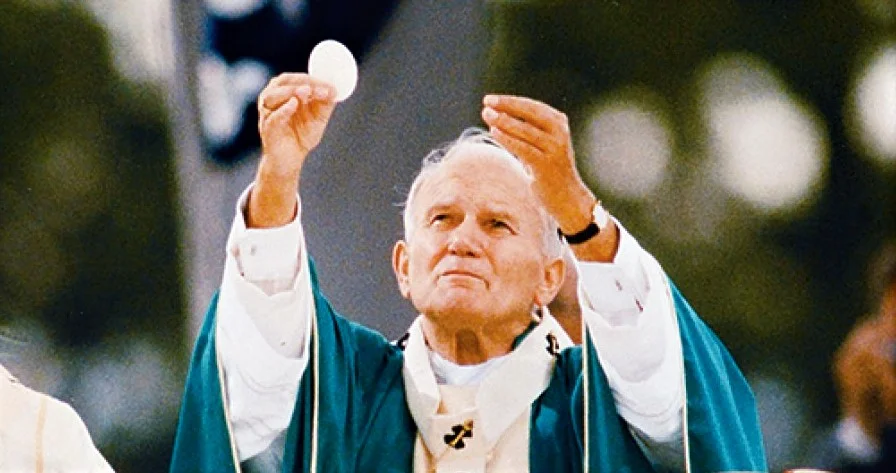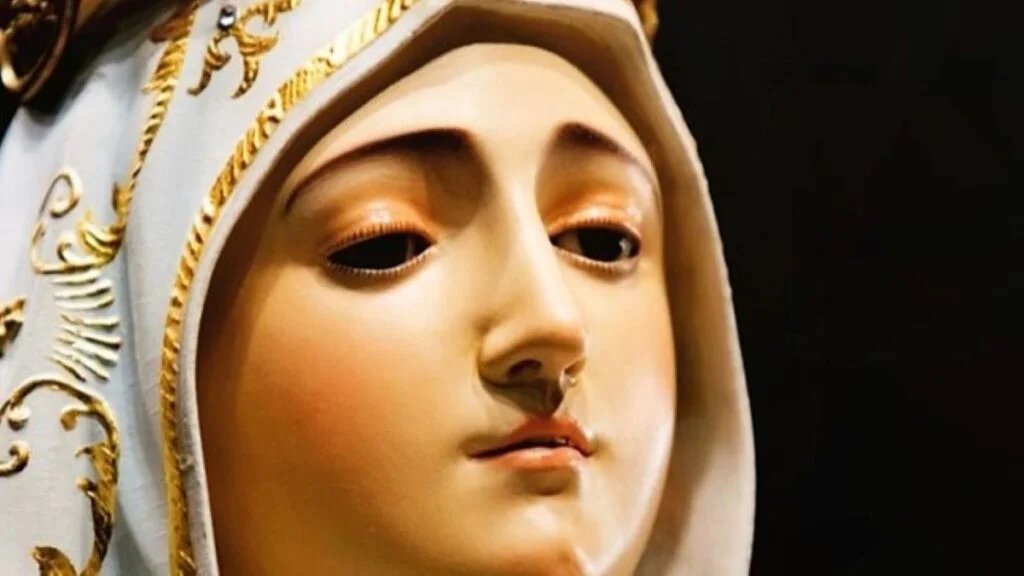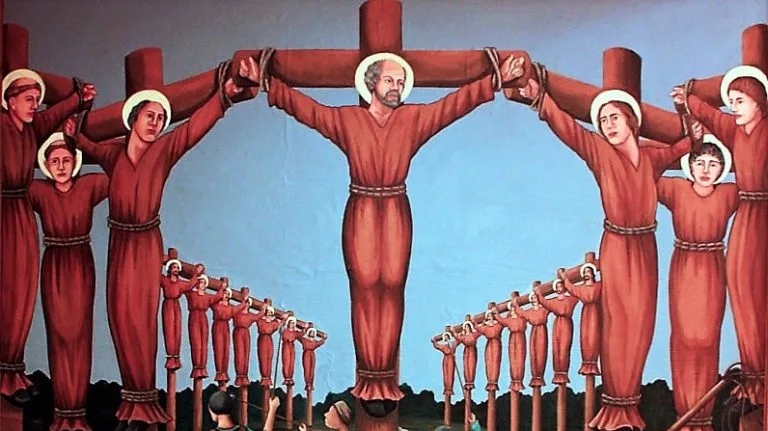OCT. 22:
ST. JOHN PAUL II, PRAY FOR US! Short bio and AV summary.

Charles Joseph Wotjtyła later known as Saint John Paul II, was born in 1920 in Wadowice, Poland. After his ordination to the priesthood and theological studies in Rome, he returned to his homeland and resumed various pastoral and academic tasks. He became first auxiliary bishop and, in 1964, Archbishop of Krakow and took part in the Second Vatican Council. On October 16, 1978 he was elected pope and took the name John Paul II. His exceptional apostolic zeal, particularly for families, young people and the sick, led him to numerous pastoral visits throughout the world. Among the many fruits which he has left as a heritage to the Church are above all his rich Magisterium and the promulgation of the Catechism of the Catholic Church as well as the Code of Canon Law for the Latin Church and for the Eastern Churches. In Rome on April 2, 2005, the eve of the Second Sunday of Easter (or of Divine Mercy), he departed peacefully in the Lord.
“Everyone knows John Paul II: his face, his characteristic way of moving and speaking; his immersion in prayer and his spontaneous cheerfulness. Many of his words have become indelibly engraved in our memories, starting with the passionate cry with which he introduced himself to the people at the beginning of his pontificate: ‘Open wide the doors to Christ, and be not afraid of him!’ Or this saying: ‘No one can live a trial life; no one can love experimentally.’ An entire pontificate is condensed in words like these. It is as though he would like to open the doors for Christ everywhere and wishes to open up to people the gate that leads to true life, to true love.”
– Pope Emeritus Benedict XVI
HAPPY FEASTDAY OF ST. JOHN PAUL II!
Let us thank God for choosing him as a faithful instrument in helping us grow more in love with Jesus! And let us ask St. John Paul II that “we may open our hearts to the saving grace of Christ, the sole Redeemer of mankind” (Opening prayer, Mass proper). Let us also thank Our Mother Mary, Our Lady of Fatima, whom our saint loved a lot and to whom he consecrated his entire life -Totus tuus!-, for protecting him from death on May 13, 1981, & St. John Paul II for all he had done for the Catholic Church and the world.
GOOD DAY FRIENDS!
O God, who are rich in mercy
and who willed that Saint John Paul the Second
should preside as Pope over your universal Church,
grant, we pray, that instructed by his teaching,
we may open our hearts to the saving grace of Christ,
the sole Redeemer of mankind.
Who lives and reigns with you in the unity of the Holy Spirit,
one God, for ever and ever.
Collect prayer, Mass proper

BIOGRAPHICAL PROFILE
JOHN PAUL II
(1920-2005)
Karol Józef Wojtyła, elected Pope on 16 October 1978, was born in Wadowice, Poland, on 18 May 1920.
He was the third of three children born to Karol Wojtyła and Emilia Kaczorowska, who died in 1929. His elder brother Edmund, a physician, died in 1932, and his father, Karol, a non-commissioned officer in the army, died in 1941.
He was nine years old when he received his First Communion and eighteen when he received the Sacrament of Confirmation. After completing high school in Wadowice, he enrolled in the Jagellonian University of Krakow in 1938.
When the occupying Nazi forces closed the University in 1939, Karol worked (1940-1944) in a quarry and then in the Solvay chemical factory to earn a living and to avoid deportation to Germany.
Feeling called to the priesthood, he began his studies in 1942 in the clandestine major seminary of Krakow, directed by the Archbishop Adam Stefan Sapieha. During that time, he was one of the organizers of the “Rhapsodic Theatre”, which was also clandestine.
After the war, Karol continued his studies in the major seminary, newly reopened, and in the school of theology at the Jagellonian University, until his priestly ordination in Krakow on 1 November 1946. Father Wojtyła was then sent by Cardinal Sapieha to Rome, where he attained a doctorate in theology (1948). He wrote his dissertation on faith as understood in the works of Saint John of the Cross. While a student in Rome, he spent his vacations exercising pastoral ministry among Polish emigrants in France, Belgium and Holland.
In 1948, Father Wojtyła returned to Poland and was appointed a curate in the parish church of Niegowić, near Krakow, and later at Saint Florian in the city. He was a university chaplain until 1951, when he again undertook studies in philosophy and theology. In 1953, Father Wojtyła presented a dissertation at the Jagellonian University of Krakow on the possibility of grounding a Christian ethic on the ethical system developed by Max Scheler. Later he became professor of moral theology and ethics in the major seminary of Krakow and in the theology faculty of Lublin.
On 4 July 1958, Pope Pius XII appointed Father Wojtyła auxiliary bishop of Krakow, with the titular see of Ombi. Archbishop Eugeniusz Baziak ordained him in Wawel Cathedral (Krakow) on 28 September 1958.
On 13 January 1964, Pope Paul VI appointed Bishop Wojtyła as Archbishop of Krakow and subsequently, on 26 June 1967, created him a Cardinal.
Bishop Wojtyła took part in the Second Vatican Council (1962- 1965) and made a significant contribution to the drafting of the Constitution Gaudium et Spes. He also took part in the five assemblies of the Synod of Bishops prior to the start of his Pontificate.
On 16 October 1978, Cardinal Wojtyła was elected Pope and on 22 October he began his ministry as universal Pastor of the Church.
Pope John Paul II made 146 pastoral visits in Italy and, as the Bishop of Rome, he visited 317 of the current 322 Roman parishes. His international apostolic journeys numbered 104 and were expressions of the constant pastoral solicitude of the Successor of Peter for all the Churches.
His principal documents include 14 Encyclicals, 15 Apostolic Exhortations, 11 Apostolic Constitutions and 45 Apostolic Letters. He also wrote five books: Crossing the Threshold of Hope (October 1994); Gift and Mystery: On the Fiftieth Anniversary of My Priestly Ordination (November 1996); Roman Triptych, meditations in poetry (March 2003); Rise, Let Us Be on Our Way (May 2004) and Memory and Identity (February 2005).
Pope John Paul II celebrated 147 beatifications, during which he proclaimed 1,338 blesseds, and 51 canonizations, for a total of 482 saints. He called 9 consistories, in which he created 231 Cardinals (plus one in pectore). He also presided at 6 plenary meetings of the College of Cardinals.
From 1978, Pope John Paul II convoked 15 assemblies of the Synod of Bishops: 6 ordinary general sessions (1980, 1983, 1987, 1990, 1994 and 2001), 1 extraordinary general session (1985) and 8 special sessions (1980, 1991, 1994, 1995, 1997, 1998 (2) and 1999).

On 3 May 1981, an attempt was made on Pope John Paul II’s life in Saint Peter’s Square. Saved by the maternal hand of the Mother of God, following a lengthy stay in the hospital, he forgave the attempted assassin and, aware of having received a great gift, intensified his pastoral commitments with heroic generosity.
Pope John Paul II also demonstrated his pastoral concern by erecting numerous dioceses and ecclesiastical circumscriptions, and by promulgating Codes of Canon Law for the Latin and the Oriental Churches, as well as the Catechism of the Catholic Church. He proclaimed the Year of Redemption, the Marian Year and the Year of the Eucharist as well as the Great Jubilee Year of 2000, in order to provide the People of God with particularly intense spiritual experiences. He also attracted young people by beginning the celebration of World Youth Day.
No other Pope met as many people as Pope John Paul II. More than 17.6 million pilgrims attended his Wednesday General Audiences (which numbered over 1,160). This does not include any of the other special audiences and religious ceremonies (more than 8 million pilgrims in the Great Jubilee Year of 2000 alone). He met millions of the faithful in the course of his pastoral visits in Italy and throughout the world. He also received numerous government officials in audience, including 38 official visits and 738 audiences and meetings with Heads of State, as well as 246 audiences and meetings with Prime Ministers.
Pope John Paul II died in the Apostolic Palace at 9:37 p.m. on Saturday, 2 April 2005, the vigil of Sunday in albis or Divine Mercy Sunday, which he had instituted. On 8 April, his solemn funeral was celebrated in Saint Peter’s Square and he was buried in the crypt of Saint Peter’s Basilica.
John Paul II was beatified in Saint Peter’s Square on 1 May 2011 by Pope Benedict XVI, his immediate successor and for many years his valued collaborator as Prefect for the Congregation for the Doctrine of the Faith.
He was canonised on 27 April 2014, together with Pope John XXIII, by Pope Francis.
Source: https://www.vatican.va/content/john-paul-ii/en/biografia/documents/hf_jp-ii_spe_20190722_biografia.html
AUDIO CREDIT: William Byrd – Civitas Sancti Tui by The Tudor Consort is licensed under a Attribution 3.0 International License.
ST. JOHN PAUL II’s GREAT SERMON DURING HIS INAUGURATION in https://catholicsstrivingforholiness.org/oct-22-st-john-paul-ii-do-not-be-afraid-open-wide-the-doors-for-christ-inaugural-sermon/
and
Stay updated: subscribe by email for free TO OUR NEW WEBSITE www.catholicsstrivingforholiness.org (PUT YOUR EMAIL IN THE SUBSCRIBE WIDGET).
We are also in www.fb.com/Catholicsstrivingforholiness. Kindly help more people in their Christian life by liking our page and inviting your family, friends and relatives to do so as well. Thanks in advance and God bless you and your loved ones! Fr. Rolly Arjonillo

